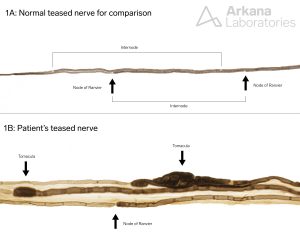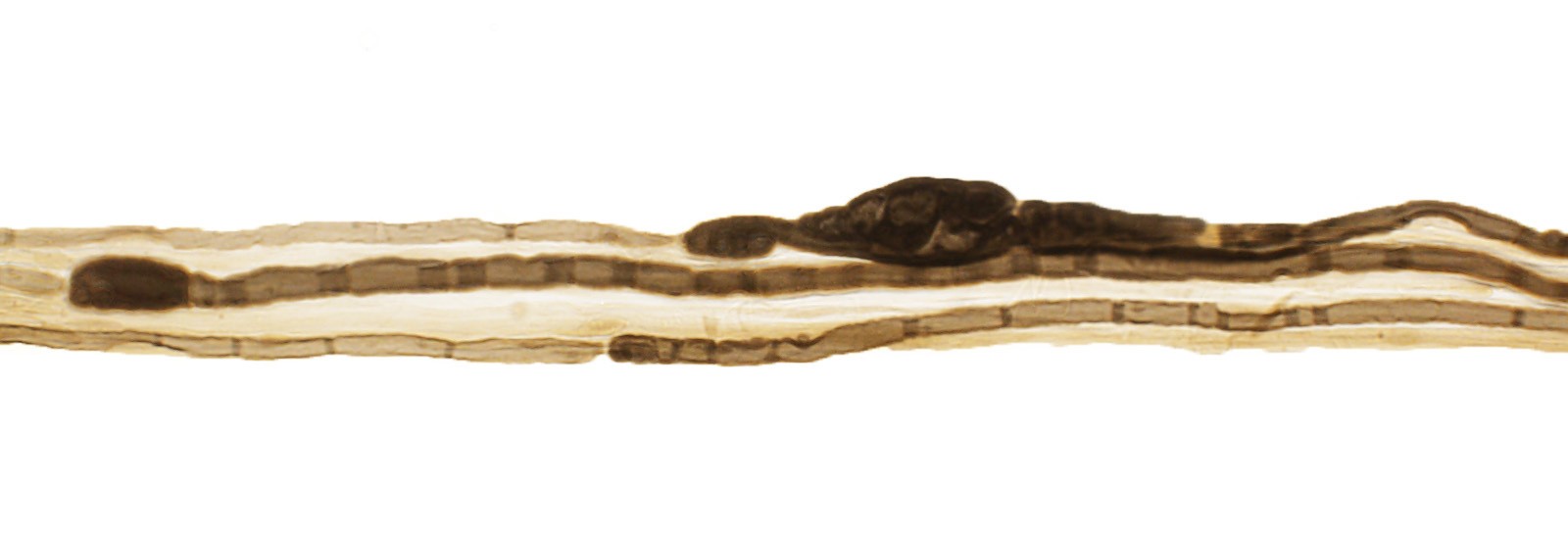This 50-year-old patient presented with multiple mononeuroathies (mononeuritis multiplex). Laboratory testing showed negative MPO and PR3 autoantibodies. Nerve biopsy was performed to evaluate for possible vasculitis.
What abnormal morphologic alteration is present in the representative image of teased nerve preparation in Figure 1B.
A. Polyglucosan body
B. Node of Ranvier
C. Myelin ovoids
D. Tomacula

Correct Answer: Tomacula
Individual myelinated axons can be visualized by staining with osmium to highlight the myelin and then carefully teasing apart the nerve fascicles. Typically greater than 100 individual teased fibers > 4 internodes in length are required for accurate evaluation. This preparation yields valuable information, but is time consuming and labor intensive.
This patients teased nerve preparation demonstrated numerous segmental fusiform to sausage-shaped areas of thickened myelin sheath (extra wraps of myelin) known as tomacula. Frequent axons showing evidence of prior segmental demyelination and subsequent successful remyelination were also present. Only a single degenerating axon characterized by contiguous myelin ovoids was seen. No inflammation or morphologic evidence of vasculitis was seen. In the context of this patient’s clinical history, the possibility of Hereditary Neuropathy with Liability to Pressure Palsies (HNPP) is felt to be most likely. Genetic testing to evaluate for heterozygous deletion of PMP22 gene is pending.
Reference(s) / additional reading:
Bird TD. Hereditary Neuropathy with Liability to Pressure Palsies. 1998 Sep 28 [Updated 2014 Sep 25]. In: Adam MP, Ardinger HH, Pagon RA, et al., editors. GeneReviews® [Internet]. Seattle (WA): University of Washington, Seattle; 1993-2019. Available from: https://www.ncbi.nlm.nih.gov/books/NBK1392/
Van Paassen BW, et al. PMP22 related neuropathies: Charcot-Marie-Tooth disease type 1A and Hereditary Neuropathy with liability to Pressure Palsies. Orphanet J Rare Dis 2014 Mar 19;9:38. doi: 10.1186/1750-1172-9-38.
Salzer JL. Schwann cell myelination. Cold Spring Harb Perspect Biol. 2015;7(8):a020529. Published 2015 Jun 8. doi:10.1101/cshperspect.a020529
Li J, et al. The PMP22 gene and its related diseases. Mol Neurobiol 2013;47:673-698
Bell C and Haites N. Genetic aspects of Charcot-Marie-Tooth disease. Arch Dis Child 1998;78:296-300
Scherer S and Arroyo EJ. Recent progress on the molecular organization of myelinated axons. J Periph Nerv Syst 2002;7:1-12
Quick note: This post is to be used for informational purposes only and does not constitute medical or health advice. Each person should consult their own doctor with respect to matters referenced. Arkana Laboratories assumes no liability for actions taken in reliance upon the information contained herein.

